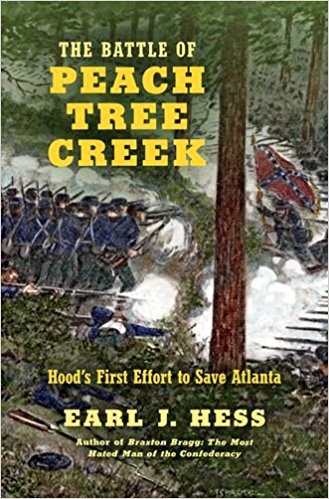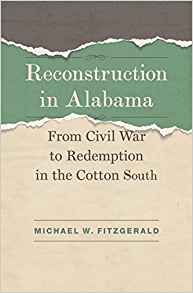The Battle of Peach Tree Creek: Hood’s First Effort to Save Atlanta by Earl J. Hess. University of North Carolina Press, 2017. Cloth, ISBN: 978-1469634197. $37.50.
 On the night of July 17, 1864, the Confederate Army of Tennessee got a new commander. General Joseph E. Johnston, who had squared off against William T. Sherman’s advance on Atlanta, found himself out of time. Since May, Johnston gave ground steadily before the federal onslaught. Jefferson Davis’s administration in Richmond had grown too restless as Johnston continued to retreat into Georgia’s heartland.
On the night of July 17, 1864, the Confederate Army of Tennessee got a new commander. General Joseph E. Johnston, who had squared off against William T. Sherman’s advance on Atlanta, found himself out of time. Since May, Johnston gave ground steadily before the federal onslaught. Jefferson Davis’s administration in Richmond had grown too restless as Johnston continued to retreat into Georgia’s heartland.
Almost immediately, Lt. Gen. John Bell Hood, Johnston’s successor, looked to attack Sherman’s men. A graduate of the West Point Class of 1853, Hood had already sacrificed a leg and an arm in service to the Confederacy; during his recuperation following the battle of Chickamauga, Hood became close to Davis. Getting his new subordinates together, Hood planned his assault.
The attack came on July 20, 1864; most of the Army of Tennessee battled across Peach Tree Creek, striking elements of George Thomas’s Army of the Cumberland. The fighting, taking place just a few miles outside of Atlanta, was brutal; by evening, Hood’s first attack as an army commander had failed. Confederate units fell back to their starting points.
The battle of Peach Tree Creek is the subject of Earl J. Hess’s latest effort. Hess, having already written on the subjects of Kennesaw Mountain and Ezra Church, adds to his Atlanta Campaign narrative with this volume. His book is of the same excellent quality that readers have come to expect from him: built on a solid foundation of both primary and secondary sources, advanced by great analysis of the tactical efforts on July 20. Each chapter covers a different sector of the battle line, so the military historian looking for minute details will find them here.
The book will almost certainly earn the ire of John Bell Hood devotees. Hess consistently blames the failure of the attacks on Hood’s shoulders, concluding, “Hood was probably the worst choice Davis…could have made. Other than an aggressive, confident spirit, Hood held no other qualifications for such an important position” (236). In the wake of that assessment, Hess adds what is essentially his thesis: “Hood’s first strike at Peach Tree Creek was a test, and the Army of Tennessee largely failed it” (235).
Hess is far more congratulatory of the federal commanders—especially George Thomas, who played a pivotal role in the Union victory. Regarding one Union defense, Hess writes, “Numbers, spirit, superior leadership, and unit cohesion decided the contest.” (128). Still, not all Union officers get a free pass. Hess, for example, points his finger at Maj. Gen. Joseph Hooker, commanding the 20th Corps, and some of his staff for “an unaccountable air of lassitude” that almost led to disaster (64). In covering other events on July 20, Hess blames Maj. Gen. James B. McPherson, commander of the Army of the Tennessee, for advancing slowly and failing to push aside a small screen of Confederate cavalry.
As has become his custom, Hess generates his own maps, but they all neglect to have keys, compasses, or scales. The larger strategic maps are easy enough to follow, but some of Hess’s maps entail individual brigade actions; without any directionality, it can be nigh impossible to place the combat in any sense of larger context. Beyond the maps, however, this is a solid work that fits neatly into the growing historiography of the Atlanta Campaign. Scholars of the campaign and the war itself would do well to pick up a copy.
Ryan Quint, a contributor to the Emerging Civil War blog, is the author of Determined to Stand and Fight: The Battle of Monocacy, July 9, 1864.
